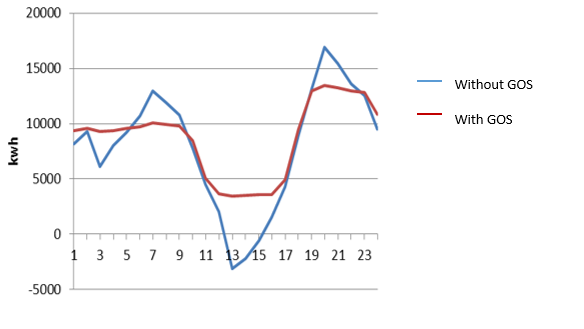RESOLVD: Test Results
The RESOLvD project’s technology has been tested in the low voltage grid of a village called L’Esquirol, in the north of Catalunya. With the technology on site, the main goal was to evaluate the impact of the project in the distribution grid, mainly at low voltage (LV) feeder level. To do so, a series of test were performed in the areas regarding efficiency, planning and quality service.

To test the efficiency of the developed technology two tests were carried out, one to evaluate the reduction of power losses by improving the waveform quality, and another one to quantify the improvement of the energy profile in a secondary substations (SS). By measuring the currents both upstream and downstream the measuring point during a 3-hour test, the final energy saved by the PED per unit of resistance was calculated to be of 166,7 W/. To improve the energy profile in the SS, the PED consumed and injected power to the grid according to the schedule provided by the grid operation schedule (GOS). A typical execution of the GOS results in a sequence of set points as depicted in Figure 2, resulting in a flatten energy profile. With this, a peak reduction of 18% was achieved, together with a decrease of 43% of the curve variability.

Two more tests were performed to measure the effect of the technology in the planning, one was calculating the increase of distributed energy resources hosting capacity of the network, and the second the reduction of the DSO investment with respect to the situation without the RESOLVD technology. After calculating both the previous to the project and posterior generation capacities of the grid, the increase due to the developed technology was estimated to be of almost 37%.
To test the improvement in quality service, 5 more tests were scheduled in the pilot area. First, the improvement of voltage profiles by power injection and consumption was calculated. This was done by setting a grid configuration that placed the PED at the end of the line and gathering and comparing the data from the two PQMs located right after the SS, in the beginning of the line, and next to the PED at the end of the line. A second test was performed to rate the prevented critical events in the grid, like congestions, over or under voltages, forecasting and remotely controlling the grid actuators. These events were artificially induced by downsizing the ampacity of a line segment and changing the grid configuration to get the maximum current flowing through this segment. This prevention of events permitted to adjust the voltage variations at SS level.
Another test was planned to get an indicator of the capability of the developed Fault Detection Application (FDA) to detect faults in the distribution grid, considering faults like deviations of voltages and/or currents from nominal values or states that could result in an unsafe, or undesired, operation of the system or a part of it. Again, artificially situations were created that could be associated with abnormal operation of the grid and resulting in a variation of currents in a magnitude representative enough for a faulty situation but not affecting the continuity of supply. This detection was calculated to have an accuracy (ratio of correctly predicted events, over total samples) of 97% and a precision (ratio of correctly detected faults over total of predicted faults) of almost 93%. Related to this, another test was carried out to calculate the time between a fault detection and the awareness and localization of this same fault. The average elapsed time from the the fault inception moment and the moment when the Fault Localization Algorithm (FDA) results are received by DSO, is 2,04 seconds, which can be qualified as a near real-time application.
Finally, the last test allowed to demonstrate that the RESOLVD technology can work on island mode, as shown in Figure 3, thanks to the energy capacity of the batteries in the PED, acting as a source. Assuming steady conditions during the whole period of island mode, and therefore a steady decrease in the state of charge of the batteries, the setup could be operative for 3 hours and 31 minutes, until reaching the complete discharge of the storage system.

All in all, it can be said that robustness of the technology has been achieved by a full electrical integration on the secondary substation of the DSO, with a main hardware component, the PED, performing with an efficiency of 94.4%. The developed technology, both hardware and software, have delivered promising results and provided the basis for further work on the next generation of innovative technologies to enable smart grids, storage and energy system integration with increasing share of renewables.

